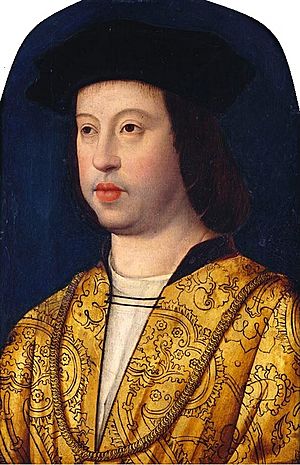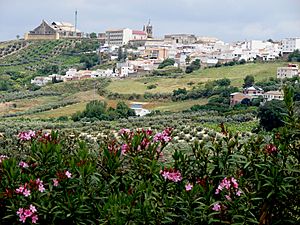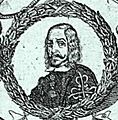Pedro Fernández de Córdoba y Pacheco facts for kids
Quick facts for kids
Pedro Fernández de Córdoba y Pacheco
|
|
|---|---|
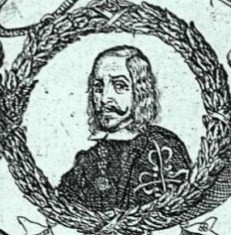 |
|
| Marquess of Priego | |
| In office 1501–1515 |
|
| Succeeded by | Catalina Fernández de Córdoba y Enríquez |
| Personal details | |
| Born | 1470 Aguilar de la Frontera, Córdoba, Spain |
| Died | 24 January 1517 Olías del Rey, Toledo, Spain |
| Nationality | Castilian |
| Occupation | Nobleman |
Pedro Fernández de Córdoba y Pacheco (1470 – 24 January 1517) was an important Spanish nobleman. He was the first Marquess of Priego. He lived during a time when Spain was becoming a very powerful country.
Pedro became one of the strongest leaders in Andalusia, a region in southern Spain. After Queen Isabella I of Castile died, he supported her daughter Joanna of Castile. This was against King Ferdinand II of Aragon, who was ruling Castile at the time.
Because of some problems in Córdoba in 1508, Pedro was arrested and sent away. But later, he was forgiven and allowed to come back.
Contents
Who Was Pedro Fernández de Córdoba?
His Family History
The Fernández de Córdoba family was a very old and important noble family in Spain. They became powerful during the Reconquista. This was a long period when Christian kingdoms took back land from Muslim rulers in Spain.
The family helped conquer the Guadalquivir valley in Andalusia. An early ancestor, Fernán Núñez, helped capture Córdoba in 1236. He was given a lot of land for his bravery.
His son, Alfonso Fernández de Córdoba, was the first to use "Córdoba" as his family name. Over time, the family gained more land and power. They became very influential in Andalusia.
Important Family Members
Pedro's great-grandfather, Gonzalo Fernández de Córdoba, received Aguilar de la Frontera from King Henry II of Castile. This town became a key place for the family.
Pedro's father was Alfonso Fernández de Córdoba IV (1447–1501). He was known as "Alonso de Aguilar" and sometimes called "El Grande" (the Great). He played a big part in the final battles to conquer the Emirate of Granada. This was the last Muslim kingdom in Spain.
Pedro's uncle was Gonzalo Fernández de Córdoba. He was a famous military leader known as the "Gran Capitán" (Great Captain). He was very skilled at organizing and modernizing the army for King Ferdinand and Queen Isabella.
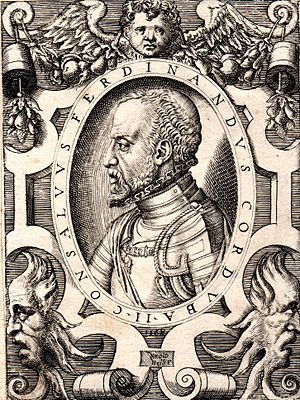
Pedro's Early Life and Family
Pedro Fernández de Córdoba y Pacheco was born in 1470 in Aguilar de la Frontera, Spain. His father was Alfonso Fernández de Córdoba IV. His mother was Catalina Pacheco.
Pedro received a good education from Peter Martyr d'Anghiera, a famous scholar. This shows that his family valued learning.
Pedro married Elvira Enriquez. Her aunt was Juana Enríquez, who was the mother of King Ferdinand II. This marriage connected Pedro to the royal family.
Pedro and Elvira had one son who died very young. They also had several daughters:
- Catalina (1495–1569): She inherited Pedro's title and became the next Marquess of Priego.
- María (1497–1560): She married Pedro Dávila y Zúñiga, a count and marquis.
- Elvira (died 1539): She married Pedro Fernández Manrique, a count.
Five of their daughters became nuns, dedicating their lives to the church.
Pedro's Career and Influence
Becoming a Powerful Nobleman
Pedro fought alongside his father in the Granada wars. In 1501, his father died during an uprising. Pedro then took over his father's lands and titles.
In December 1501, King Ferdinand and Queen Isabella honored Pedro's father by making Pedro the first Marquess of Priego. This meant his lands were now a special noble territory called a "marquisate."
Pedro held many important jobs. He was the Chief Justice and Chief of Police for Córdoba. He was also the Governor of several important castles, including the Alcázar de los Reyes Cristianos.
One of Pedro's first actions as Marquess was to form an alliance with other powerful nobles. This group wanted to protect their special rights against new royal officials and the Inquisition. The Inquisition was a powerful church court.
Expanding His Lands
Pedro also worked to expand his family's control. In 1503, he bought the town and castle of Montalbán de Córdoba. This area was important because it was near his family's lands in Aguilar.
Pedro paid a very large sum for Montalbán. He then helped new families move there and start farms. This helped the town grow and become more populated.
Challenges with the King
After Queen Isabella died in 1504, there was a struggle for power in Castile. Pedro supported Isabella's daughter, Queen Joanna. This put him against King Ferdinand, who was Joanna's father and was ruling Castile.
Pedro became a leader for Joanna's supporters in Córdoba. This led to tension with other nobles who supported King Ferdinand. In 1506, the rivalry almost caused a fight in the city.
In 1507, people in Córdoba protested against a harsh church official. Some believed Pedro encouraged these protests. King Ferdinand sent officials to investigate the problems.
Pedro was briefly removed from his job as Chief of Police. He even imprisoned one of the king's investigators. This made the king very angry.
Trial and Pardon
Pedro's uncle, the "Gran Capitán", told him how upset the king was. So, Pedro went to Toledo in September 1508 to explain himself to King Ferdinand.
The king was very strict. He made Pedro give up his strongholds and removed him from all his offices. He also took away Pedro's property and ordered his castle at Montilla to be destroyed. Pedro was also fined a huge amount of money.
Pedro was sent back to Córdoba and put on trial for treason. He was found guilty and sentenced to death. However, his sentence was changed to exile. He was sent away to the Kingdom of Valencia.
In 1510, Pedro was finally forgiven. His jobs and properties were given back to him. After this, he lived a quieter life.
Pedro Fernández de Córdoba y Pacheco died on January 24, 1517, in Olías del Rey, Toledo. He is buried in the Monastery of San Lorenzo in Montilla, Córdoba.
Images for kids
See also
 In Spanish: Pedro Fernández de Córdoba y Pacheco para niños
In Spanish: Pedro Fernández de Córdoba y Pacheco para niños


